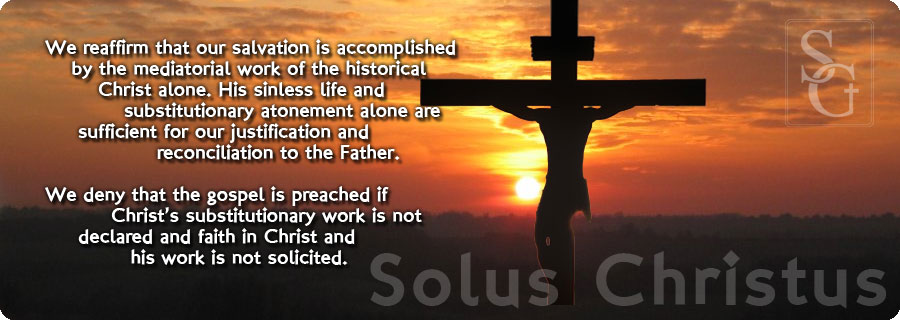agedman,
No...I think it should be developed even more, and clarified....
For example....when we say Jesus is the "True Tabernacle"...that is not to say the first earthly physical tabernacle was somehow...FALSE.
It is just that OT. redemptive history finds it's purpose and fulfillment in Jesus.
What do you mean?Some have said they never heard of such a thing.
What do you mean by the term?
If your background is dispensational they would not link the events together in this way. They break everything apart...I do not think and can not remember seeing these ideas in my premill books.
This is totally different.
ok...are any that have been mentioned so far?
Again...can you show some that are distinct?
16 And it shall come to pass, when ye be multiplied and increased in the land, in those days, saith the Lord, they shall say no more, The ark of the covenant of the Lord: neither shall it come to mind: neither shall they remember it; neither shall they visit it; neither shall that be done any more.
17 At that time they shall call Jerusalem the throne of the Lord; and all the nations shall be gathered unto it, to the name of the Lord, to Jerusalem: neither shall they walk any more after the imagination of their evil heart.
I am sorry but i do not agree with this at all..first off;
39 But he answered and said unto them, An evil and adulterous generation seeketh after a sign; and there shall no sign be given to it, but the sign of the prophet Jonas:
40 For as Jonas was three days and three nights in the whale's belly; so shall the Son of man be three days and three nights in the heart of the earth.
41 The men of Nineveh shall rise in judgment with this generation, and shall condemn it: because they repented at the preaching of Jonas; and, behold, a greater than Jonas is here.
The men I am quoting were very careful and well studied.
This statement seems to be to miss what is being offered in this thread to a large extent...
That is not what this is about.
Any interaction should be to agree or disagree, and offer helpful input, or biblical correction..This post is not meant to be critical, or in any manner dispute what Icon has presented.
Is the term "new and true exodus" supposed to be something of latest discovery?
No...I think it should be developed even more, and clarified....
For example....when we say Jesus is the "True Tabernacle"...that is not to say the first earthly physical tabernacle was somehow...FALSE.
It is just that OT. redemptive history finds it's purpose and fulfillment in Jesus.
Did this sentence come out the way you wanted it to say?This thread is not highly instructive and certainly well presented.
Which parts in particular were you most familiar with before this discussion?However, the instruction of this thread is not "new"
and some title of "New and True Exodus" is not really new and has always been true.
What do you mean?Some have said they never heard of such a thing.
What do you mean by the term?
Maybe if you offer your understanding it will clarify the confusion...So, I'm a bit confused about the term "new and true" being used.
Again, that is not in any manner meant to disparage or demean the presentation, but I read trying to find something new, only to read agreement with pretty much all presented as having already taught in the past.
If your background is dispensational they would not link the events together in this way. They break everything apart...I do not think and can not remember seeing these ideas in my premill books.
This thread is not one of many just using the term the way a high school english class might discuss things that are parallel to the Exodus account.The most extreme conservative or liberal teachers usually teach (in some manner at least) the exodus lead by Moses was a type of the journey and experience of many people, not just believers, the church, the Christ, but is used by many even outside the faith. The civil rights era was typically presented as such an exodus.
This is totally different.
okHere is a bit of words about typology as used in the Scriptures that all must be cautioned and aware.
Do you see evidence of this here?All typology is nothing but a picture of what is real, and care must be taken in combining presentations of typology inappropriately.
Do you see any of this here?For example: A series of crime scene photos may not represent the same crime or, if they do, may not represent the same aspects of the same crime. The OT typology may represent various aspects of either the same or a completely different reality.
Not all exodus events are types.
ok...are any that have been mentioned so far?
..Not all types in the OT Israeli exodus are of the same reality. Some may be applicable to the Christ, some may be applicable to the believer, and some to the unsaved, and some to the worship and some.
Again...can you show some that are distinct?
Show what you mean...comment on sections you think do not fit in...What is and must be guarded, in a thread of this magnitude, is application to prophetic statements of the future.
You need to clarify this, I think the men quoted see it more like a movie, then isolated snapshots....that is more dispensational thought, for example in post 56 there is a list of verses...consider this one...As typology is only a picture, and not a movie, it is important to keep the background in focus as well as the central figure.
16 And it shall come to pass, when ye be multiplied and increased in the land, in those days, saith the Lord, they shall say no more, The ark of the covenant of the Lord: neither shall it come to mind: neither shall they remember it; neither shall they visit it; neither shall that be done any more.
17 At that time they shall call Jerusalem the throne of the Lord; and all the nations shall be gathered unto it, to the name of the Lord, to Jerusalem: neither shall they walk any more after the imagination of their evil heart.
For example: Here might be a comparison of picture and movie presentation of typology. Christ stated that the sign of Jonah was a type. The picture was three nights in the belly of the fish. Basically, that was all that the type was to portray. The movie version would be to include all that lead up to the event, and take into account what happened during and immediately following the fishy experience. That is not using typology appropriately. Typology is not a movie, it is not an allegory. One must be careful in assembling the typology together and not put a picture in a wrong grouping.
I am sorry but i do not agree with this at all..first off;
39 But he answered and said unto them, An evil and adulterous generation seeketh after a sign; and there shall no sign be given to it, but the sign of the prophet Jonas:
40 For as Jonas was three days and three nights in the whale's belly; so shall the Son of man be three days and three nights in the heart of the earth.
41 The men of Nineveh shall rise in judgment with this generation, and shall condemn it: because they repented at the preaching of Jonas; and, behold, a greater than Jonas is here.
The men I am quoting were very careful and well studied.
The exodus contains typology, but the exodus was not a typology movie.
Too often, in "exodus" typology, movie version presentation is attempted. The journey itself becomes the story rather than the true focus of the typology.
This statement seems to be to miss what is being offered in this thread to a large extent...
The world does this movie presentation version by using the exodus as a journey from one estate to another (again the civil rights concern of the 60's).
That is not what this is about.
The True Exodus...is About Jesus...The TRUE ISRAEL...and all the elect..IN HIM.The journey of the believer may echo that of the Exodus, but the exodus was not the believer. We may be presented in a type, but the experience and circumstance of our journey is one who is endowed with the Holy Spirit. We are a better then Moses, for we do not visit a burning bush, climb a mountain, sit in the doorway of inquiry... to visit with God, but may humbly and boldly enter into His conversations with others to plead for our cause.

